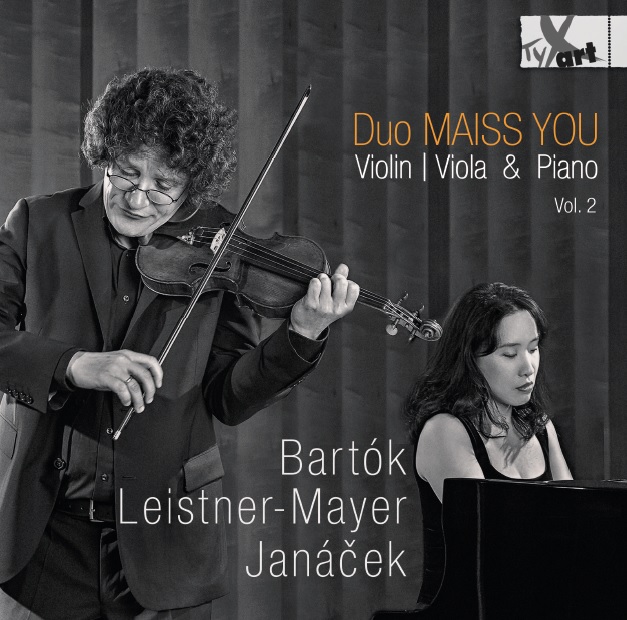
 BARTÓK: Violin Sonata No. 2. LEISTNER-MAYER: Viola Sonata. JANÁČEK: Violin Sonata / Duo Maiss You: Burkhard Maiss, vln/vla; Ji-Yeoun You, pno / TyxArt TXA 19130
BARTÓK: Violin Sonata No. 2. LEISTNER-MAYER: Viola Sonata. JANÁČEK: Violin Sonata / Duo Maiss You: Burkhard Maiss, vln/vla; Ji-Yeoun You, pno / TyxArt TXA 19130
Duo Maiss You consists of German violinist-violist Burkhard Maiss, a founding member of the Jacques Thibaud Trio whose prior experience include first-chair positions (on both instruments) with various chamber orchestras, and Korean pianist Ji-Yeoun You who pursued a solo career which won her awards before working as a chamber musician. Under Maiss’ leadership, they have truly become a “German duo” in the traditional sense of the term: they employ a warm, rich sound on all three instruments and tend towards a lyrical, legato style of interpretation.
This is immediately borne out in their recording of the Bartók Second Violin Sonata. Maiss plays with a languorous warmth and relaxation in the first movement, more than I was used to from other recordings, while You plays with a rich, deep-in-the-keys approach that belies her previous successes in the delicate, wispy music of Mozart and Chopin concerti. Nor do they let the dramatic aspects of this sonata go by without great attention to detail and robust playing. I particularly like the fact that Maiss’ violin retains its fullness in the upper register while using a quick, fast vibrato; this neither undernourishes his tone nor overdoes the throbbing vibrato that other violinists bring to the music. His playing, however, is not as lean and angular as that of Bartók’s favorite violinist, Joseph Szigeti, though he comes surprisingly close in the second movement. (Bartók favored Szigeti because of his somewhat tight, wiry tone, which he felt was perfect for the Magyar folk music on which many of his works were based.) According to the liner notes, part of the naturalness of sound of this recording came from a combination of digital and analog (tube) microphones. I would attest that this combination worked perfectly to capture a natural sound.
Roland Leistner-Mayer’s Viola Sonata, of which this is the first recording, is early Modern in style. The composer, born in 1945, has never been a fan of the atonal or bitonal schools of composition, but one can hear within this basically tonal work a number of fascinating details, such as chromatic movement of both the top line and the harmony as well as the occasional use of modality. It surely resembles the work of Sibelius or Bartók quite strongly. Like them, Leistner-Mayer is not a composer who wallows in pathos or bathos; rather, his music clearly has a backbone and avoids easy categorization. I would also toss in the solo violin sonatas of Ysaÿe as another example of early Modern music that still holds considerable interest today. Duo Maiss You is deeply involved in this music, drawing out every bit of raw emotion in it. Perhaps the fact that they recorded this work in the composer’s presence has much to do with this.
I was utterly fascinated by the music from start to finish; occasionally, Leistner-Mayer uses strong motor rhythms to propel the music, as in the explosive second-movement “Scherzo,” but rhythm is not his only or primary device. Rather it is, as suggested by the expansive first and third movements, more involved with bringing out a deep melancholy rather than trying to entertain audiences with easy-to-assimilate devices. Indeed, this third-movement “Adagio” is almost a little world in itself, rising from melancholy to a volatile outburst of passion, after which the sadness is somewhat mitigated, as if he has discovered a way to internalize it and help it pass through him. Yet later on, he returns to the melancholy; he just can’t shake it.
The sonata ends with an “Allegro agitato” that sounds so Eastern European that one will have a hard time believing that he is a German composer. Here, as in the “Scherzo,” the strong rhythms return, and his use of modes (combined with chromatic key shifts) sound so much like Bartók that I think you’ll be amazed. But he is only like Bartók, not a carbon copy of him, just as the music of Giuseppe Martucci was like Brahms without using a single quote from the German master he admired so much. The mood also shifts in this movement, but away from the explosive opening towards a sadder theme reflecting inner anguish. Surprisingly, it ends abruptly, almost in the middle of nowhere.
The Duo also dives deep into the Janáček Violin Sonata, one of the few chamber works by this excellent composer (great instrumental music, ugly operatic music) I hadn’t heard before. One thing about Maiss and You is that they seem to never play anything at less than 100% intensity, something I appreciate in any artist. The dramatic moments are highly explosive and the lyrical ones sweeping, with a broad legato feel that nonetheless never lacks feeling. The slow second movement of this sonata, though quite interesting, is not angst-ridden but, rather, almost a love song, but even here the Duo approaches it with a view to bringing out as much emotion as they possibly can. In the occasionally edgy, occasionally lyric third movement, they alternate between the musical moods with stunning emotional shifts, and they continue their attention to detail in the slow but by no means placid fourth movement.
This is clearly one of the best chamber music releases of the year, highly recommended.
—© 2020 Lynn René Bayley
Follow me on Twitter (@Artmusiclounge) or Facebook (as Monique Musique)
